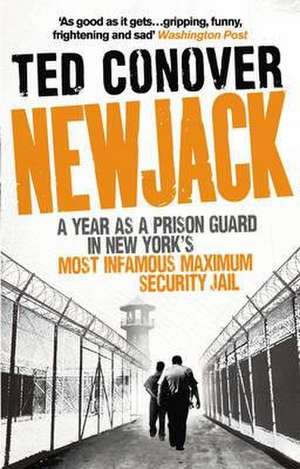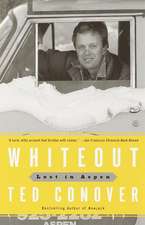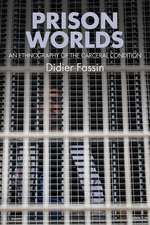Newjack
Autor Ted Conoveren Limba Engleză Paperback – 4 mai 2011
| Toate formatele și edițiile | Preț | Express |
|---|---|---|
| Paperback (2) | 96.43 lei 3-5 săpt. | |
| Vintage Publishing – 31 mai 2001 | 96.43 lei 3-5 săpt. | |
| Ebury Publishing – 4 mai 2011 | 100.35 lei 3-5 săpt. | +9.79 lei 10-14 zile |
Preț: 100.35 lei
Nou
Puncte Express: 151
Preț estimativ în valută:
19.22€ • 19.80$ • 16.10£
19.22€ • 19.80$ • 16.10£
Carte disponibilă
Livrare economică 01-15 februarie
Livrare express 21-25 ianuarie pentru 19.78 lei
Preluare comenzi: 021 569.72.76
Specificații
ISBN-13: 9780091940959
ISBN-10: 0091940958
Pagini: 352
Dimensiuni: 128 x 198 x 27 mm
Greutate: 0.24 kg
Editura: Ebury Publishing
ISBN-10: 0091940958
Pagini: 352
Dimensiuni: 128 x 198 x 27 mm
Greutate: 0.24 kg
Editura: Ebury Publishing
Extras
AUTHOR'S NOTE
This is a work of nonfiction, describing events that I witnessed and participated in. No scenes are imaginary or made up, though some dialogue was, of necessity, re-created. Like all officers, I kept a small spiral notebook in my breast pocket for note-taking; unlike most of them, I took many notes. Most of the individuals in the book are identified by their real names. But to protect the privacy of certain officers and inmates, I have made up the following names for real people:
Aragon , Rufino, Van Essen, Antonelli, Hawkins, Gaines, Foster, Wickersham, Perch, Arno, Chilmark, Pacheco, Dobbins, Duncan, Scarff, Bella, St. George, Saline, McCorkle , Birch, Pitkin, Popish, Massey, Lopez, Dieter , Phelan, De Los Santos, Di Carlo, Perlstein, Garces, DiPaols, Billings, Riordan, Speros, Mendez, Delacruz, Malaver, Larson, Perez, Fay, Blaine, Addison, L'Esperance, Sims, Blaine, Michaels, Astacio.
CHAPTER 1
INSIDE PASSAGE
Six-twenty a.m. and the sun rises over a dark place. Across the Hudson River from Sing Sing prison, on the opposite bank, the hills turn pink; I spot the treeless gap in the ridgeline where, another officer has told me, inmates quarried marble for the first cellblock. Nobody could believe it back in 1826: a work crew of convicts, camping on the riverbank, actually induced to build their own prison. They had been sent down from Auburn, New York State's famous second prison, to construct Sing Sing, its third. How would that feel, building your own prison?
That 1826 cellblock still stands, on the other side of the high wall I park against; the prison has continued to grow all around it. In 1984, the roof burned down. At the time, the prison was using the building as a shop to manufacture plastic garbage bags, but as late as 1943, it still housed inmates. Sometimes now when inmates complain about their six-by-nine cells, I tell them how it used to be: two men sharing a three-and-a-half-by-seven-foot cell, one of them probably with TB, no central heating or plumbing, open sewer channels inside, little light. They look unimpressed.
I park next to my friend Aragon, of the Bronx, who always puts The Club on his steering wheel; I see it through his tinted glass. This interests me, because, with a wall tower just a few yards away, this has got to be one of the safest places to leave your car in Westchester County. Nobody's going to steal it here. But Aragon is a little lock-crazy: He has screwed a tiny hasp onto his plastic lunch box and hangs a combination lock there, because of the sodas he's lost to pilfering officers, he says. Between the Bronx and prison, a person could grow a bit lock-obsessed.
There's no one else around. Most people park in the lots up the hill, nearer the big locker room in the Administration Building. But it's almost impossible for a new officer to get a locker in there, so I park down here by the river and the lower locker room. The light is dim. Gravel crunches under my boots as I head into the abandoned heating plant.
This six-story brick structure is one of those piles of slag that give Sing Sing its particular feel. Massive, tan, and almost windowless, it looks like a hangar for a short, fat rocket. The whole thing is sealed off, except for a repair garage around the corner and a part of the first floor containing men's and women's locker rooms and rest rooms.
The men's locker room-I've never seen the women's-is itself nearly abandoned; though it's stuffed with a hodgepodge of some two hundred lockers of inmate manufacture, fewer than twenty are actively used. The rest have locks on them, some very ancient indeed, belonging to officers who quit or transferred or died or who knows what. Nobody keeps track. An old wall phone hangs upside down by its wires on the left as you enter, the receiver dangling by its curly cord, a symbol of Sing Sing's chronically broken phone system.
Cobwebs, in here, find a way onto your boots. For a few weeks following my arrival, on Aragon's advice I checked the room for lockers that might have opened up. None ever did. All those unused lockers needlessly tied up. This might not be a problem for the officers who drive to work from the north, but down south in the Bronx (I live there, too) you don't want to advertise that you're a correction officer: Too many people around you have been in prison. Officers tend not to stick the big badge decals they pass out at the Academy on their car windows (because they like their windows), and most, like me, don't want to walk the street wearing a uniform. It's just awkward. A locker lets you leave your uniform at work.
My second month, I found one old lock that was so flimsy I could almost twist it off with my hands, but not quite. I brought in a small tire iron and it came off easily. Inside were plastic cups, magazine pictures of women in bikinis, and newspapers from 1983. I've since heard of a locker coming available in the Administration Building, but I'm not pursuing it. I've come to prefer it down here. The feel of neglect is somehow truer to the spirit of Sing Sing.
It's barely fifteen minutes till lineup. I throw on my gray polyester uniform, making sure I've got all the things I need on my belt: radio holder, latex-glove packet, two key-ring clips, baton ring. I put pen and pad, inmate rulebook, and blue union diary in my breast pockets, slide my baton through the ring, lock the padlock, and slam the locker door. I walk past a pile of old office desks and, by necessity, into the men's room. It smells like an outhouse. I sit down, for the second time this morning. Every morning is like this, and it is for the other new guys, too: Your stomach lets you know, just before the shift starts, what it thinks of this job.
A decrepit footbridge takes me over the tracks of the Metro North railroad-Sing Sing may be the only prison anywhere with a commuter railroad running through it-and other officers start to appear. My climb continues, up a wooden staircase that's been built atop a crumbling concrete one.
Here is the Administration Building parking lot, and the main entrance to the prison. Parked in the middle is the "roach coach," purveyor of coffee and rolls. To the right is the entrance to the Visit Room, not yet open. To the left, officers are lined up, waiting to deposit their handguns at the outside window of the Arsenal. For reasons lost to time, New York State correction officers are allowed to own and carry concealed weapons, and most seem to enjoy doing so. However, they can't bring the guns inside with them (nobody is allowed to carry inside)-and few of us have any doubt that prison is the safer for it. I take the last steps to the main gate and flash the badge and I.D. card I carry in a special wallet that I picked up at the Academy. The officer takes a cursory peek inside my lunch bag-the contraband check. I punch my time card and proceed to the morning's worst moment, getting my assignment.
The desk of Sergeant Ed Holmes is the focal point of the lineup room. It's on a raised platform, in front of a window. From up there, Holmes can see everybody in the room and most of those ascending the front steps. His eyes are constantly scanning, never settling on any person or object for more than an instant, moving from an officer to the printout in front of him and back again. The printout tells him what jobs he'll need to fill-who's on his day off, who's got vacation, who's out sick, who's on suspension. He checks off old-timers as he sees them-they've chosen their jobs and know where they're going. It's the new guys, like me, who are at his mercy.
Holmes is one of the tough black officers who have been here forever, a big man who seems to enjoy his distance from the rank and file. Several white-shirts spoke to us during orientation, mostly about how the institution runs. Holmes was different. He came only to warn: Don't fuck with me, he said, glancing at the back wall of the room. I'm gonna give you your job assignment, and if you complain, I'll give you a worse one tomorrow. I have no "Okay, it's been pretty quiet. They had one guy cut in the leg, in the tunnel from A-block yard. No weapon, no perp, the usual. Then we found three shanks buried in the dirt there in B-block yard, two of 'em metal, that we found with metal detectors. You think they're just sitting around out there, but these crooks are always conniving." In other words: one inmate stabbed, assailant unknown, knife not found; three homemade knives found; no officers hurt. A fairly typical day. Then a new sergeant steps forward:
"Remember, there's no double clothing allowed during rec, for the obvious reasons. Inmates with two shirts on or two sets of pants should be sent back to their cells and not allowed in the yard or gym." Double clothing is understood to be both a defense against getting "stuck" and a way of quickly changing your appearance if you stick someone else.
Often we'll hear a moral message at lineup, too: a warning that we're not stepping up to the inmates enough or a caution that we need to watch one another's backs better and know the names of the people we're working with or a reminder that our job is "to get out of here in one piece at three PM-as if that needed saying. No such message today. There's the schedule of driver's-Ed courses, for anyone interested, and a reminder of next week's blood drive, and the announcements are over.
"Officers, a-ten-shun!" yells a sergeant. Everyone is quiet. "Posts!" And we're off, not exactly at a run, through the long, rough corridors and up the hill to begin the day.
Sing Sing sprawls over fifty-five acres, most of it rocky hillside. It's flat down where I parked, near the river-the old cellblock and the railroad tracks. The former Death House, site of the electric chair that killed 614 inmates between 1891 and 1963, is down there too. (It's now a vocational-training building.) And so is Tappan, the medium-security unit of Sing Sing, with some 550 inmates housed in three 1970s-vintage shoe box-shaped buildings.
But most of Sing Sing is on the hill, and from the lineup room, we climb there. Getting to B-block is the longest walk; it's the remotest part of the "max" jail. There are a couple of ways to go; both involve a lot of stairs. Officers sip from coffee cups and swing lunch bags as we make the slow march up to work. We are black and white and Latino, male and female. Members of the skeleton night crew pass us in the hall and wave wanly; most have that gray night-shift look. They trade normal diurnal rhythms for the perk of having very little inmate contact-at night, all the inmates are locked in their cells. If I didn't have a family, I might put in for night duty.
The corridors and stairways are old, often in disrepair. When it rains, we skirt puddles from leaking roofs. When it's cold, we have reason to remember that these passages are unheated. The tile-roofed tunnels snake around Sing Sing, joining the various buildings, and at the beginning and end of each-sometimes even in the middle-there is a locked gate. Most of the officers posted to these gates have big, thick keys, but at one gate the guard pushes buttons instead, as they do in modern prisons. By the time I pass through the heavy front door of B-block, there are ten locked gates between me and freedom.
A-block and B-block are the most impressive buildings in Sing Sing, and in a totally negative sense. A large cathedral will inspire awe; a large cellblock, in my experience, will mainly horrify.
The size of the buildings catches the first-time visitor by surprise, and that's largely because there's no preamble. Instead of approaching them from a wide staircase or through an arched gate, you pass from an enclosed corridor through a solid-metal door that's not much bigger than your front door at home. And enter into a stupefying vastness. A-block, probably the largest freestanding cellblock in the world, is 588 feet long, twelve feet shy of the length of two football fields. It houses some 684 inmates, more than the entire population of many prisons. You can hear the man encompassing, overwhelming cacophony of radios, of heavy gates slamming, of shouts and whistles and running footsteps but, oddly, at first you can't see a single incarcerated soul. All you see are the bars that form the narrow fronts of their cells, extending four stories up and so far into the distance on the left and right that they melt into an illusion of solidity. And when you start walking down the gallery, eighty-eight cells long, and begin to make eye contact with inmates, one after another after another, some glaring, some dozing, some sitting bored on the toilet, a sense grows of the human dimensions of this colony. Ahead of you may be a half-dozen small mirrors held through the bars by dark arms; these retract as you draw even, and you and the inmate get a brief but direct look at each other.
A-block and B-block are aligned with each other, end to end, and span the top of Sing Sing; between them sits the mess-hall building. Both were completed in 1929, and they're very similar in structure, except B-block is twenty cells shorter (sixty-eight), and one story taller (five). Though few civilians have seen anything like them, there is nothing architecturally innovative about the design. It plainly derives from the 1826 cellblock, which was the prototype for most American cell-house construction: tiny cells back to back on five tiers, with a stairway at either end and one at the center of the very long range.
From the ground floor, which in both buildings is known as the flats, you can look up and see how each structure is made up of two almost separate components. One is the all-metal interior, containing the inmates; it's painted gray and looks as though it could have been welded in a shipyard. The other is comprised of the exterior walls and roof, a brick-and-concrete shell that fits over the cells like a dish over a stick of butter. One does not touch the other: Should an inmate somehow escape from his cell, he's still trapped inside the building. A series of tall, barred windows runs down either side of the shell. They would let in twice as much light if they were washed. As it is, they let pass a diffuse, smog-colored glow, which crosses about fifteen feet of open space on each side before it reaches the metal, which it does not warm. There is a flat, leaky roof, which does not touch the top of the metal cellblock but leaves a gap of maybe ten feet. If the whole structure were radically shrunk, the uninitiated might perceive a vaguely agricultural purpose; the cages might be thought to contain chickens, or mink.
The blocks are loud because they are hard. There is nothing inside them to absorb sound except the inmates' thin mattresses and their bodies. Every other surface is of metal or concrete or brick.
A crowd of officers is milling around a cell near the front gate of B-block when I get there; this cell is the office of the officer in charge, or OIC. Rooms for staff were not included in B-block's plan, so a few cells near the front gate have been converted for that purpose. Next to the OIC's office, an identical, tiny cell houses the sergeants; two of them are squeezed in there. Next to that is the coat room, which contains a barely functioning microwave oven and a refrigerator that won't stay closed. There's an office for paperwork and filling out forms, and one for a toilet-the only staff toilet on these five floors.
For many years, the day-shift OIC has been Hattie "Mama" Cradle, a fifty-something woman five feet tall and just about as big around. She's got a clipboard in her hand and horn-rimmed reading specs on a chain around her thick neck. Officers give her their names and job numbers; she tells them where they're posted. I hang back a little, but then there's no more stalling: "Conover, two fifty-four," I say. She gets the spelling off the tag on my shirt, then, already poised to jot down the next name, says, "R-and-W"
My heart sinks. It's as bad as it could be. I am the first officer on the second-floor galleries, known by the letters R and W I've worked there a few times before, including my very first-horrifying-day of on-the-job training, when I accompanied a novice officer, or "newjack," who barely knew what he was doing. Today I'm that newjack, going it alone.
I crowd into Cradle's office and look for my keys-four separate rings of the big, heavy "bit" keys, which work cell doors, with center-gate, end-gate, and fire-alarm keys thrown on for good measure. I attach these to my belt, and feel the weight. My heart is pounding, but there's nothing for it. I find a fresh battery for the floor's portable communications radio and grab a sheaf of forms that I have to fill out during my shift. Last is the list of "keeplocks." I copy mine from Cradle's bulletin board, noting that there are two new ones in the past twenty-four hours. Keeplocks are inmates on disciplinary restriction. In the old days there were few such inmates, and often they would be sent to solitary confinement, known as the Special Housing Unit or the Box. But now their numbers overwhelm the Box, so they stay put, mixed in with the general population-except they can't come out of their cells. One of our main responsibilities as gallery officers is to keep the keeplocks locked up. Because we're always in a hurry and often don't know the inmates, this is harder than it sounds. It's easy to unlock the wrong door.
I pass through two more gates on my way upstairs and relieve the night officer on R-and-W Since the galleries are all locked down at night, mainly her job is to check, every hour or so, that every inmate is still breathing. It's not a bad job, and if an inmate does die, it's no problem-unless he's found with rigor mortis. In that case, she will lose her job, because of the cold, hard proof that she wasn't really checking. The night officer hands me the radio and some other keys. Does she know what the new keeplocks are in for? I ask.
"I don't know, I don't care, they're not my friends, and I don't like them," she says with a suddenness and finality that I find kind of funny. She hands me the radio, which I attach to my belt. She's left some wrappers and tissues around the desktop, but I don't mention it; she looks tired. I envy her as she puts on her coat: She's going home and doesn't have to deal with the inmates any longer. "The cells are all deadlocked," she adds before leaving, which means that not only is the huge bar, or "brake", in place which locks them all at once but that the cells are locked individually. Inmates are not at large at night, swarming around you on their way to chow, arguing with you when it's time to "lock in," calling you names, stressing you out. Pandora's box is closed. My first job of the day, with breakfast less than an hour away, will be to open it.
From the Hardcover edition.
Notă biografică
Ted Conover was raised in Colorado and lives in New York City. His previous two books, Whiteout and Coyotes, were named Notable Books of the Year by The New York Times. He has written for The New Yorker and is now a contributing writer to The New York Times Magazine.
From the Hardcover edition.
Recenzii
“An amazing book…. The stories are spellbinding and the telling is clear and cold.”–The Washington Post Book World
“[Conover] has made us fully part of his experience…. It is hard to imagine any journalist doing this more daringly or effectively.”–The New York Times
“A timely, troubling, important book.”–The Baltimore Sun
“Newjack is a graphic and troubling window into society’s scrapheap. Conover is to be commended for having the chops to venture where few others would dare go.... An important cautionary tale.”–Los Angeles Times Book Review
“Newjack tells the straight skinny on a guard’s life inside prison without being overly judgmental or cloyingly sentimental. It’s experimental journalism at its best.”–The Denver Post
“A devastating chronicle of the toll prison takes on the prisoners and the keepers of the keys.”–Minneapolis Star Tribune
“An incisive and indelible look at the life of a corrections officer and the dark life of the penal system.”–The Dallas Morning News
“A fascinating story.... Prison books crowd the shelves, but few tell the story from the point of view of the officers who spend eight hours a day doing time, hoping and praying that they make it home that night, hoping and praying that the job allows them to remain human.”–The San Diego Union-Tribune
“[Conover] has made us fully part of his experience…. It is hard to imagine any journalist doing this more daringly or effectively.”–The New York Times
“A timely, troubling, important book.”–The Baltimore Sun
“Newjack is a graphic and troubling window into society’s scrapheap. Conover is to be commended for having the chops to venture where few others would dare go.... An important cautionary tale.”–Los Angeles Times Book Review
“Newjack tells the straight skinny on a guard’s life inside prison without being overly judgmental or cloyingly sentimental. It’s experimental journalism at its best.”–The Denver Post
“A devastating chronicle of the toll prison takes on the prisoners and the keepers of the keys.”–Minneapolis Star Tribune
“An incisive and indelible look at the life of a corrections officer and the dark life of the penal system.”–The Dallas Morning News
“A fascinating story.... Prison books crowd the shelves, but few tell the story from the point of view of the officers who spend eight hours a day doing time, hoping and praying that they make it home that night, hoping and praying that the job allows them to remain human.”–The San Diego Union-Tribune














